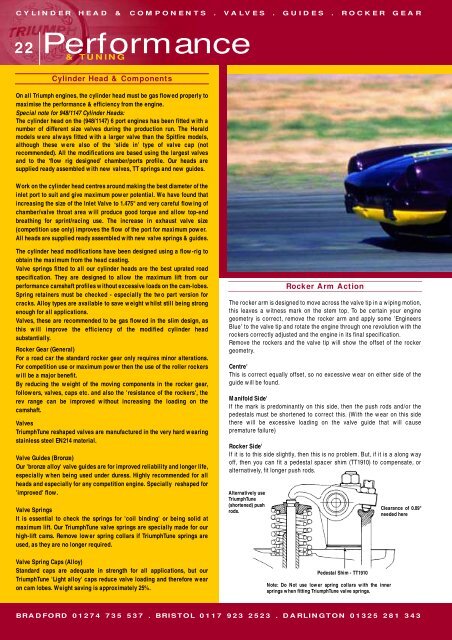You also want an ePaper? Increase the reach of your titles
YUMPU automatically turns print PDFs into web optimized ePapers that Google loves.
CYLINDER HEAD & COMPONENTS . VALVES . GUIDES . ROCKER GEAR<br />
22<br />
Performance<br />
& TUNING<br />
Cylinder Head & Components<br />
On all Triumph engines, the cylinder head must be gas flowed properly to<br />
maximise the performance & efficiency from the engine.<br />
Special note for 948/1147 Cylinder Heads:<br />
The cylinder head on the (948/1147) 6 port engines has been fitted with a<br />
number of different size valves during the production run. The Herald<br />
models were always fitted with a larger valve than the Spitfire models,<br />
although these were also of the ‘slide in’ type of valve cap (not<br />
recommended). All the modifications are based using the largest valves<br />
and to the ‘flow rig designed’ chamber/ports profile. Our heads are<br />
supplied ready assembled with new valves, TT springs and new guides.<br />
Work on the cylinder head centres around making the best diameter of the<br />
inlet port to suit and give maximum power potential. We have found that<br />
increasing the size of the Inlet Valve to 1.475" and very careful flowing of<br />
chamber/valve throat area will produce good torque and allow top-end<br />
breathing for sprint/racing use. The increase in exhaust valve size<br />
(competition use only) improves the flow of the port for maximum power.<br />
All heads are supplied ready assembled with new valve springs & guides.<br />
The cylinder head modifications have been designed using a flow-rig to<br />
obtain the maximum from the head casting.<br />
Valve springs fitted to all our cylinder heads are the best uprated road<br />
specification. They are designed to allow the maximum lift from our<br />
performance camshaft profiles without excessive loads on the cam-lobes.<br />
Spring retainers must be checked - especially the two part version for<br />
cracks. Alloy types are available to save weight whilst still being strong<br />
enough for all applications.<br />
Valves, these are recommended to be gas flowed in the slim design, as<br />
this will improve the efficiency of the modified cylinder head<br />
substantially.<br />
Rocker Gear (General)<br />
For a road car the standard rocker gear only requires minor alterations.<br />
For competition use or maximum power then the use of the roller rockers<br />
will be a major benefit.<br />
By reducing the weight of the moving components in the rocker gear,<br />
followers, valves, caps etc. and also the 'resistance of the rockers', the<br />
rev range can be improved without increasing the loading on the<br />
camshaft.<br />
Valves<br />
TriumphTune reshaped valves are manufactured in the very hard wearing<br />
stainless steel EN214 material.<br />
Valve Guides (Bronze)<br />
Our 'bronze alloy' valve guides are for improved reliability and longer life,<br />
especially when being used under duress. Highly recommended for all<br />
heads and especially for any competition engine. Specially reshaped for<br />
'improved' flow.<br />
Valve Springs<br />
It is essential to check the springs for 'coil binding' or being solid at<br />
maximum lift. Our TriumphTune valve springs are specially made for our<br />
high-lift cams. Remove lower spring collars if TriumphTune springs are<br />
used, as they are no longer required.<br />
Valve Spring Caps (Alloy)<br />
Standard caps are adequate in strength for all applications, but our<br />
TriumphTune 'Light alloy' caps reduce valve loading and therefore wear<br />
on cam lobes. Weight saving is approximately 25%.<br />
Rocker Arm Action<br />
The rocker arm is designed to move across the valve tip in a wiping motion,<br />
this leaves a witness mark on the stem top. To be certain your engine<br />
geometry is correct, remove the rocker arm and apply some 'Engineers<br />
Blue' to the valve tip and rotate the engine through one revolution with the<br />
rockers correctly adjusted and the engine in its final specification.<br />
Remove the rockers and the valve tip will show the offset of the rocker<br />
geometry.<br />
Centre'<br />
This is correct equally offset, so no excessive wear on either side of the<br />
guide will be found.<br />
Manifold Side'<br />
If the mark is predominantly on this side, then the push rods and/or the<br />
pedestals must be shortened to correct this. (With the wear on this side<br />
there will be excessive loading on the valve guide that will cause<br />
premature failure)<br />
Rocker Side'<br />
If it is to this side slightly, then this is no problem. But, if it is a along way<br />
off, then you can fit a pedestal spacer shim (TT1910) to compensate, or<br />
alternatively, fit longer push rods.<br />
Alternatively use<br />
TriumphTune<br />
(shortened) push<br />
rods.<br />
Pedestal Shim - TT1910<br />
Note: Do Not use lower spring collars with the inner<br />
springs when fitting TriumphTune valve springs.<br />
Clearance of 0.09"<br />
needed here<br />
BRADFORD 01274 735 537 . BRISTOL 0117 923 2523 . DARLINGTON 01325 281 343


